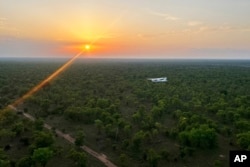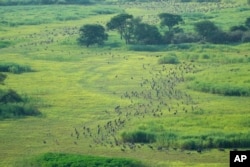South Sudan is home to what some wildlife experts say is the world’s largest land animal migration, or seasonal movement of animals. But government officials fear illegal hunting threatens the animals and may hurt the development of a sustainable tourism industry.
Migration
An estimated 6 million antelope participated in a migration last year, the country’s first major aerial wildlife study says.
The estimate from the nonprofit African Parks, which did the work along with the government, is far greater than estimates of other large animal movements around the world.
The recently released study used data collected over a two-week period in two national parks and nearby areas, covering a continuous area of 122,774 square kilometers.
But the group warned that the animals face a rising threat from illegal hunting. The country is filled with weapons but does not have strong law enforcement.
Mike Fay is a scientist who led the study.
Fay said, “Saving the last great migration of wildlife on the planet is an incredibly important thing.” He added, “There’s so much evidence that the world’s ecosystems are collapsing...”
Conflict and problems
The east African nation is still emerging from five years of fighting that started in 2013 and killed nearly 400,000 people. Elections scheduled for last year were delayed to this December, but few preparations are in place for those.
Violence continues in some areas, with some 2 million people displaced and 9 million — 75 percent of the population — depending on humanitarian aid, the United Nations says.
The migration is already being talked about as a point of national pride by a country trying to move beyond its past. Large advertisements of the migration recently went up in the capital city of Juba. And the government hopes the animals will bring many visitors to the country.
South Sudan has six national parks and over ten game reserves covering more than 13 percent of the land.
The migration stretches from east of the Nile River in Badingilo and Boma parks into neighboring Ethiopia. It includes four main antelope, the white-eared kob — of which there are some 5 million — the tiang, the Mongalla gazelle and the bohor reedbuck.
The study said some numbers of animals have increased since a more limited one in 2010. But it described a “catastrophic” decline of most non-migratory species in the last 40 years, such as the hippo, elephant and warthog.
Associated Press reporters flying over the migration of antelope in early June saw few giraffes and no elephants, lions or cheetahs.
Trying to protect the animals over such a large area is difficult.
In recent years, new roads have increased people’s access to markets, leading to more illegal hunting. Years of flooding have meant crop failures that have left some people with little choice but to hunt for food. African Parks estimated some 30,000 animals were being killed each month between March and May this year.
Villagers near the parks told AP they mostly hunted to feed their families or to exchange the animals for goods.
The government has not made protecting wildlife a main concern. Less than 1 percent of its budget is spent on the wildlife ministry, which said it has few cars to move rangers around to protect animals. Those rangers say they have not been paid since October. In addition, the rangers say that illegal hunters have more weapons than they do.
But South Sudan President Salva Kiir Mayardit said the country is committed to turning its wealth of wildlife into sustainable tourism. He said he wanted the Ministry of Wildlife to increase training and equip rangers to fight illegal hunting.
I’m John Russell.
Sam Mednick reported on this story for the Associated Press. John Russell adapted it for VOA Learning English.
______________________________________________
Words in This Story
sustainable – adj. involving methods that do not completely use up natural resources
tourism – n. the activity of traveling to a place for fun or pleasure
antelope – n. an animal that looks like a deer and runs very fast
ecosystem – n. everything that exists in an environment or area
pride – n. a feeling of self-respect or happiness
catastrophic – adj. of or relating to disaster; describes great damage or a disaster
species – n. a group of animals or plants that can produce young animals or plants
access – n. a way of getting at, near, or to something
ranger – n. a person who protects part of a public forest













Forum